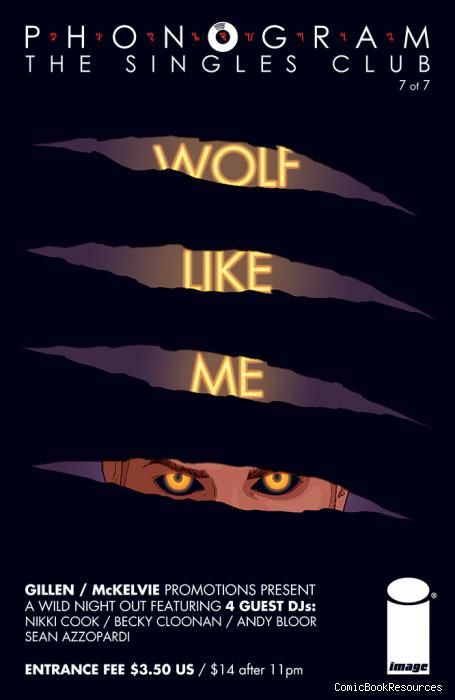And so we reach the finale of "Phonogram." Maybe even forever. For the final story, Gillen and McKelvie stick with a time-tested crowd-pleasing conclusion: they end on a song.
Of course, this being "Phonogram," it's not quite what you'd expect. Marrying music with comics is a difficult thing to do, and even the likes of Neil Gaiman and Alan Moore have tried and failed more than once. Mostly, any attempts to put a song in a comic end up as little more than an illustrated poem -- lyrical, but not really musical.
Gillen and McKelvie, however, understand that to turn a song into a comic, you don't focus so much on the words, but the rhythm and imagery. From the first few pages, it becomes clear that this is a comic with a tempo. Gillen sets the beats, page by page, panel-by-panel, while McKelvie realizes the mood of the song with his carefully constructed visuals. When I first read this issue, I hadn't heard the song it references (TV on the Radio's "Wolf Like Me") but, a few pages in, I knew that this "silent" issue was intended as a comicbook cover version of the song it was named after. Having since listened to the track in question, I understand better how it fits together, but it's hard not to be impressed at how the story can evoke a soundtrack even when you don't know what it sounds like.
The star of this issue is the irrepressible Kid-With-Knife, who first appeared way back when "Phonogram" was still in its infancy. For a series that spends a lot of its time deconstructing its subject matter, it seems like a brave choice to end the series with one of two characters in the series who doesn't intellectualize music at all. Indeed, when Kohl teaches him how to use Phonomancy, he openly demolishes the series' central conceit replying: "That's magic? Hell, everybody does that."
Of course, as much as technique and message are important, there's a story to tell as well. As the "concluding" issue to a story told from multiple viewpoints, it does somehow manage to tie itself back to the first issue, and learning the final, terrible fate of Penny B (in a fantastically rendered scene) does provide emotional circularity to the series, and may well break a few hearts at the same time.
It would be a disservice to conclude this review without mentioning the backup strips -- 4 in total -- which include a brilliantly incongruous Viking-based contribution from Becky Cloonan. The rest span the length of the "Phonogram" chronology. The first, by Nikki Cook, goes right back to the original death of the goddess Britannia, a prologue to Rue Britannia, while the third provides a coda to the same series. It seems particularly amusing that the (physically and chronologically) final strip, drawn by Sean Azzopardi, closes out the series with an analysis of the Talking Heads song, Once in a Lifetime -- which I shouldn't have to remind anyone spins on the line "My God, what have I done?" A piece of micro-commentary on "Phonogram" if ever there was one.
And that, more or less, is it. "Phonogram" was, if nothing else, a reviewer's comic. It had depth, subtlety, and best of all, it had a point it wanted to make. There are valid criticisms you could charge the series with. Perhaps you found it cliquey. Perhaps you found it pretentious. Perhaps you simply thought a story about people in a nightclub wasn't really that interesting. But Phonogram was different, and ambitious, and more often than not, it met its own criteria and then some. It played with storytelling, and with format, and it did it all while looking great and having the kind of dialogue you can quote. Whatever your personal opinion of the series, you have to admit that the shelves will feel much emptier without a new Phonogram to look forward to.

